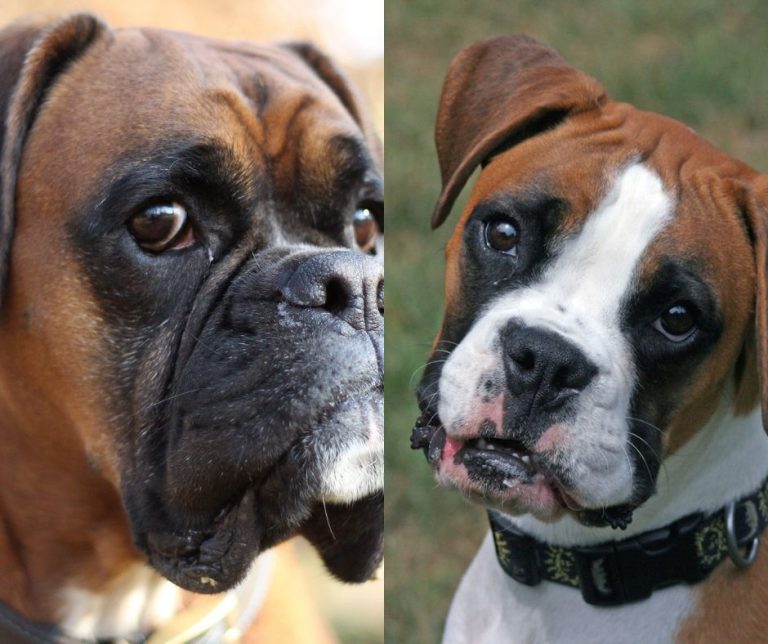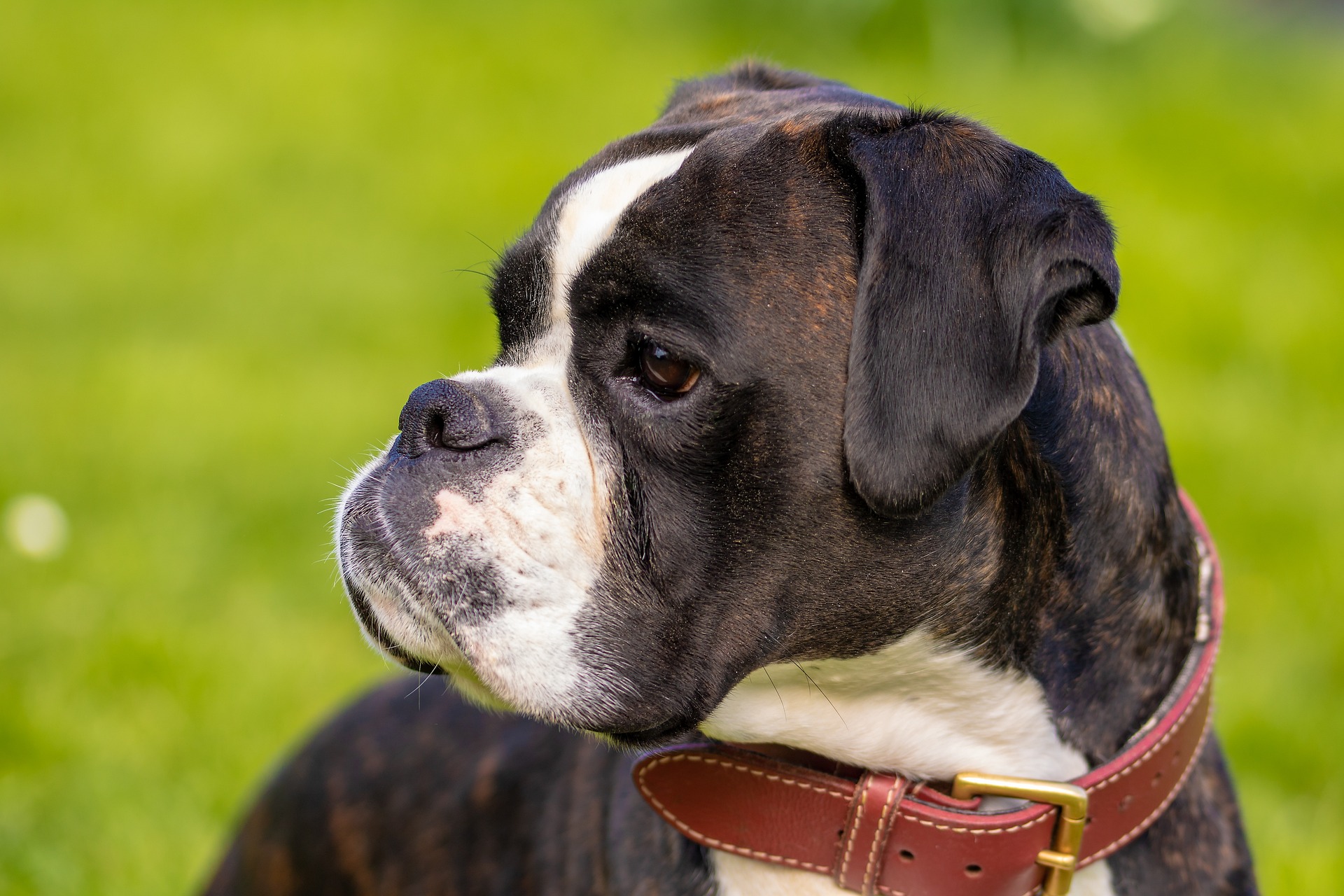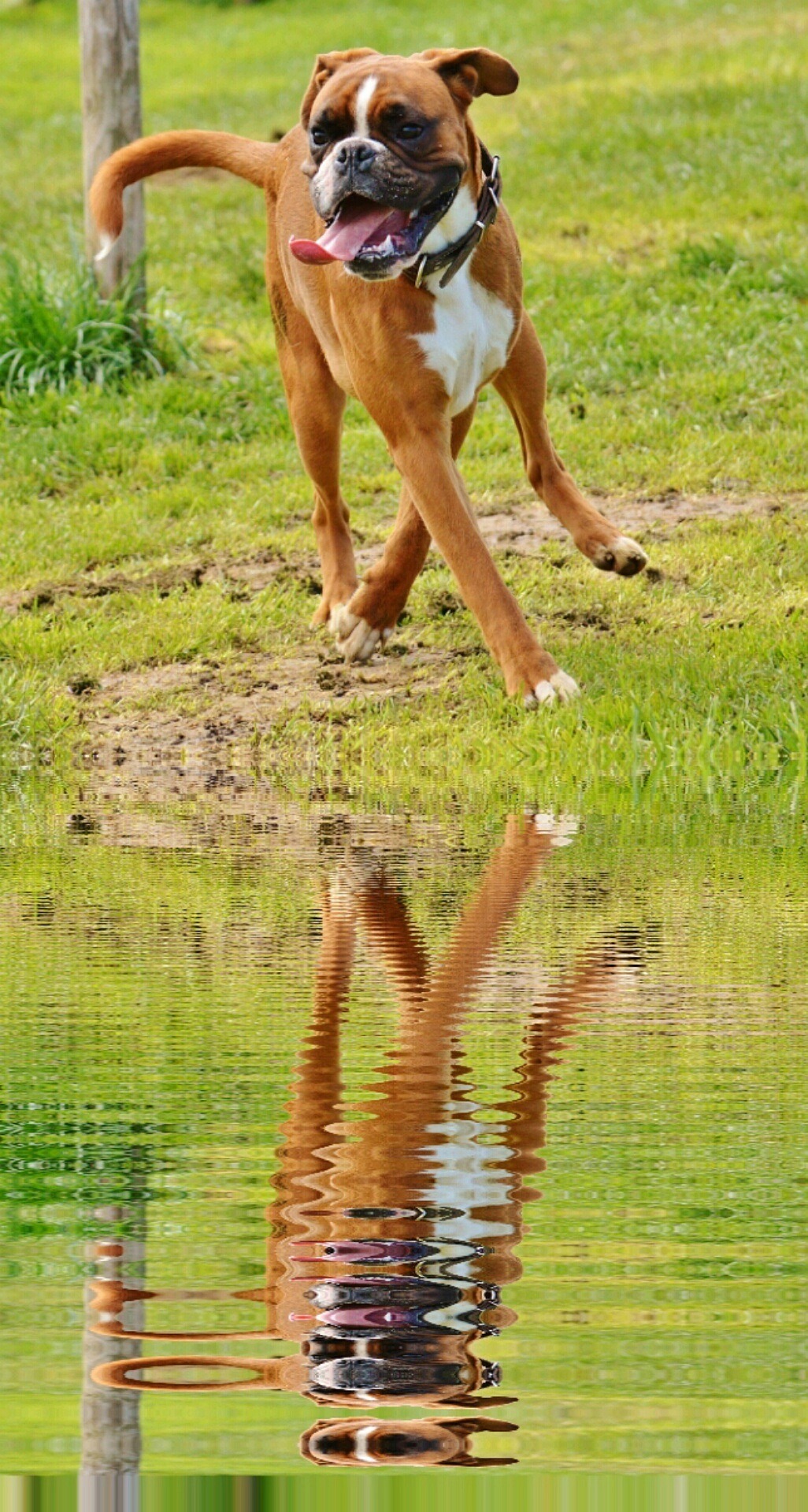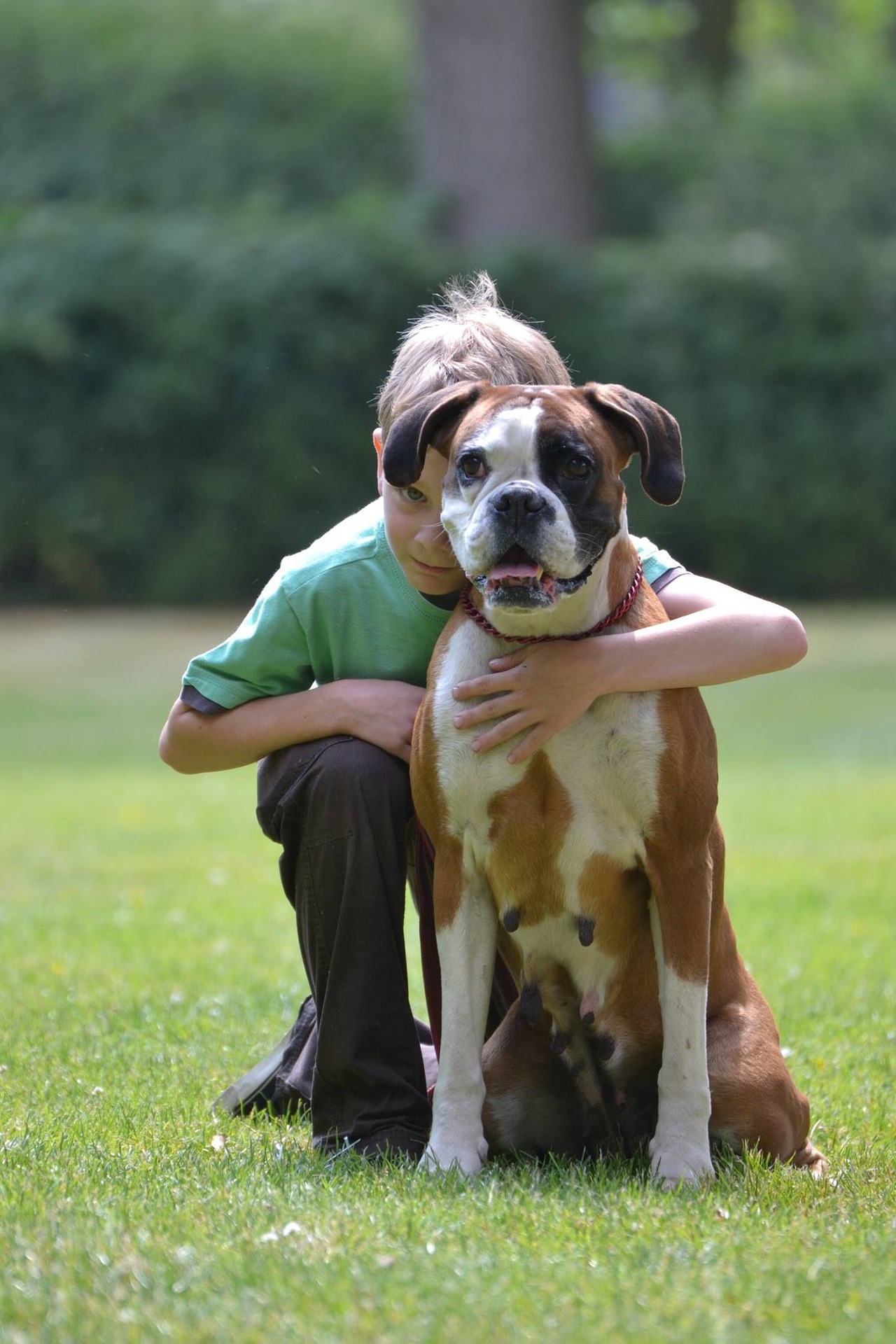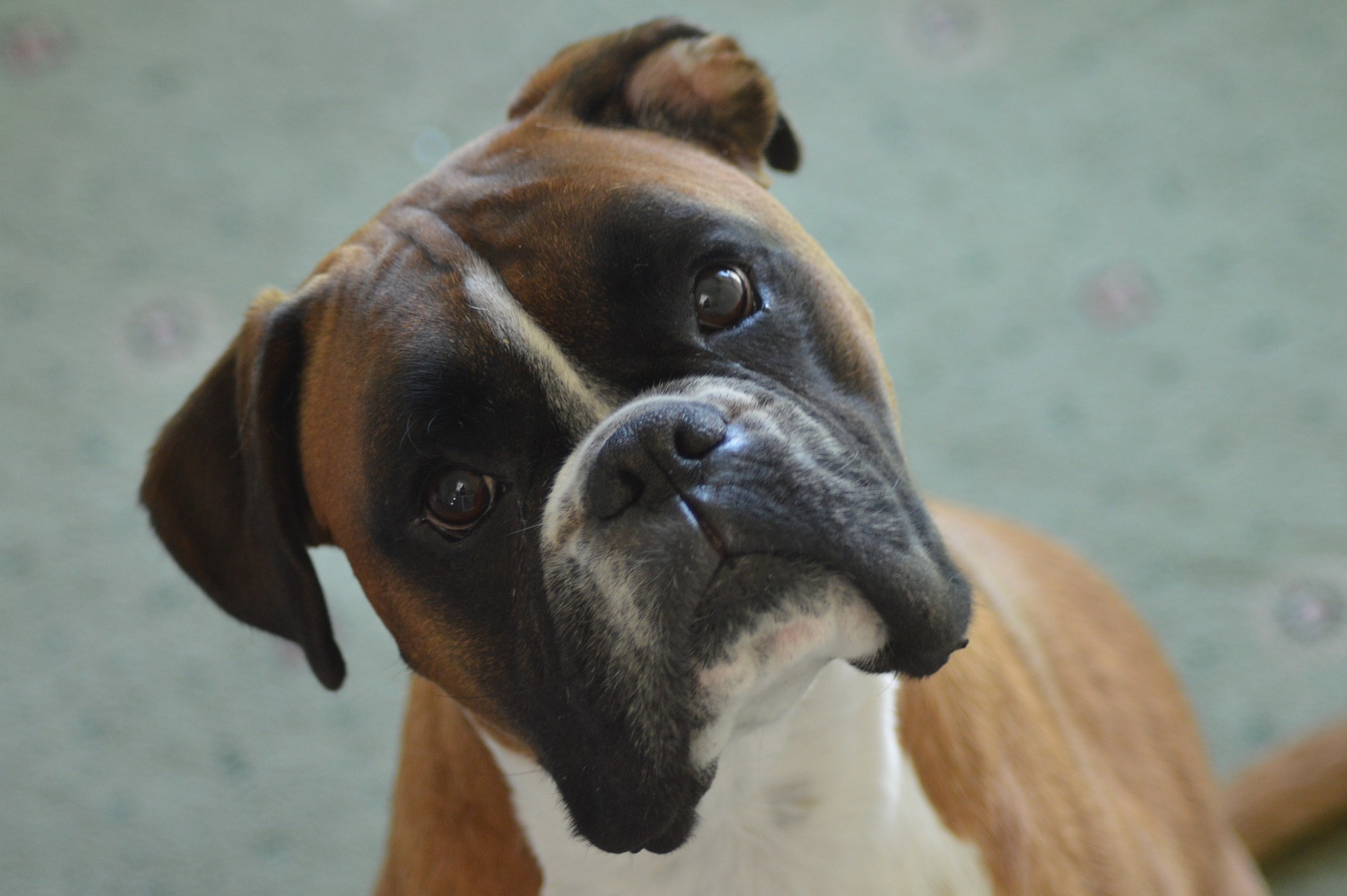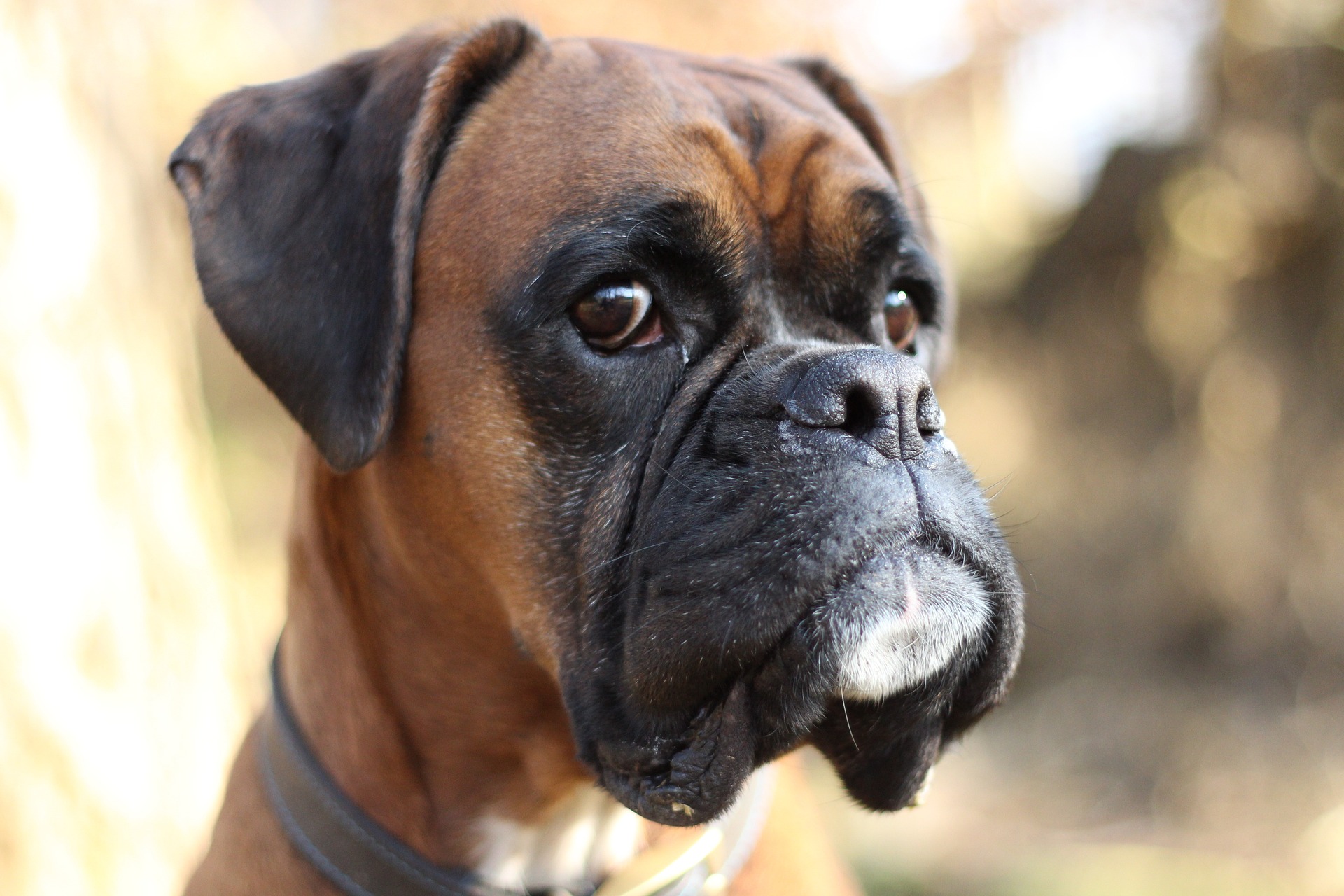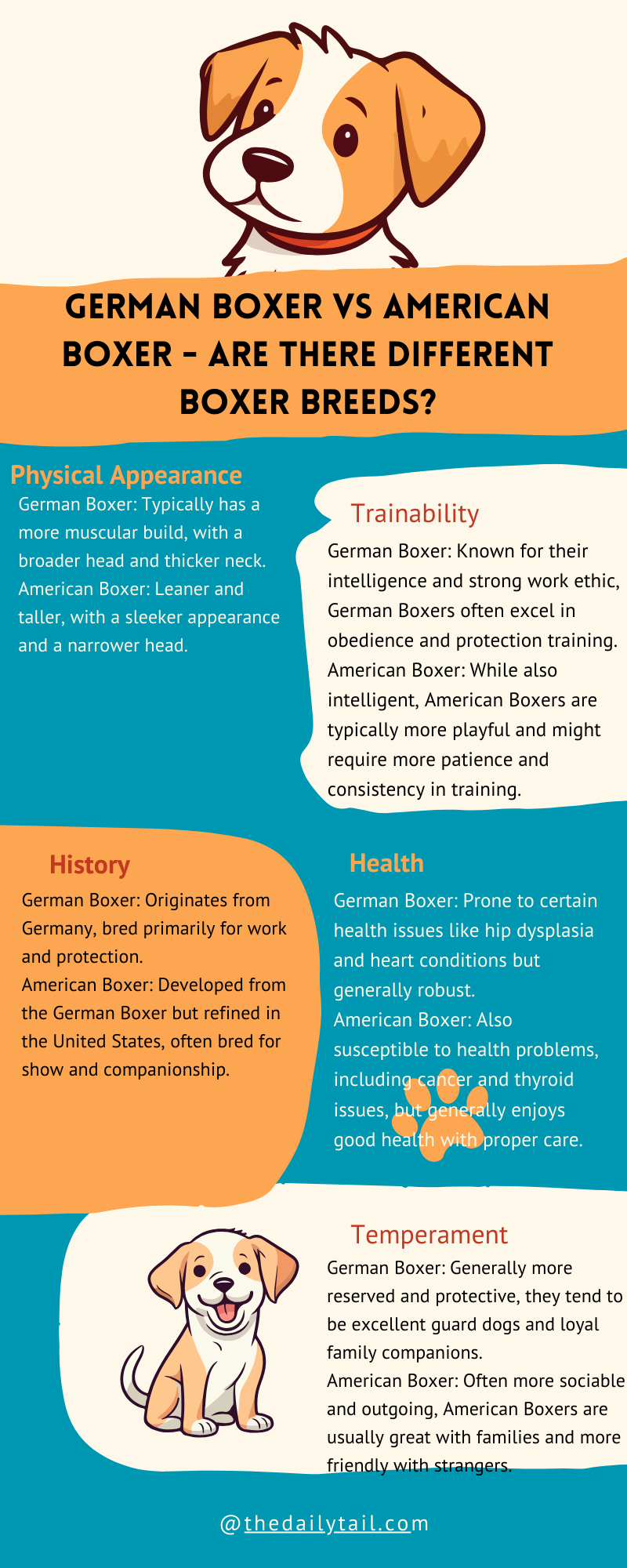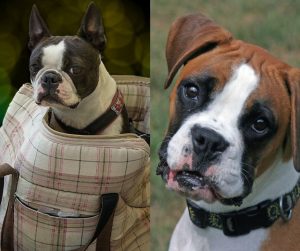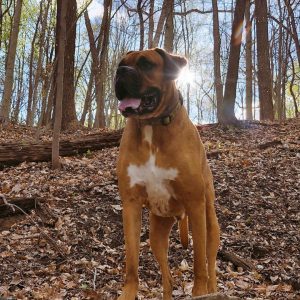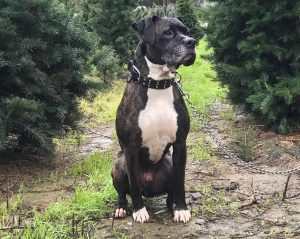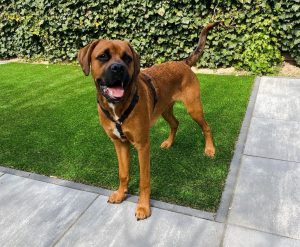When I first started learning about Boxer dogs, I was surprised to find out that there are different types like American and German Boxers. While they may look similar to the casual observer, enthusiasts like me have come to appreciate the subtle differences that set them apart.
The American Boxer is often described as a more slender dog with a slightly different build compared to its German counterpart, which tends to be more robust. But it’s not just about looks; their temperaments and abilities have distinct characteristics too.
It’s intriguing to see how each type has been shaped by their history and the standards set by their breed’s origin.
I’ve noticed that when people choose a Boxer, they often consider which type might be right for their lifestyle.
For those who need a working dog, the German Boxer is renowned for its trainability and obedience. In my own experience, American Boxers can be a bit more independent, which can be charming in its own way.
Of course, health is a big topic too. Some say that different standards in breeding can result in differing health outcomes for these pups, so that’s something else to think about.
So, how much do you know about different Boxer breeds? Let’s take a look at the comparison between German Boxer vs American Boxer dog breed.
Key Takeaways
- American and German Boxers differ in build, with the American being slimmer and the German more robust.
- The German Boxer is known for its trainability, while the American Boxer may exhibit more independence.
- Health considerations vary between the two types due to different breeding standards.
History and Origins of Boxer Breeds
Looking into the past of these strong and hearty dogs, I find fascinating tales of their development in two different continents. From the bustling streets of Germany to the wide-open spaces of America, these dogs have made quite a journey.
German Boxer Roots
Now, let me tell you about the German Boxer. It’s amazing to think that the Boxer breed got its start way back in the old days. These pups originally hail from Germany, and their history is quite rich.
The German Boxer is a proud descendant of a breed known as the Bullenbeisser as well as the Mastiff, and they’ve got a strong heritage. The Bullenbeisser was a dog that was used for hunting, and it had the job of taking down big game, holding it tight until the hunters arrived.
Over time, these robust dogs were bred to be smaller, and this is where the modern German Boxer comes into play. They were eventually mixed with bulldogs from Great Britain, and this combination gave the Boxer breed a broad and muscular build, with a strong jaw perfect for hanging onto things.
I mean, with a heritage like that, no wonder they’re such powerful dogs.
American Boxer Development
Moving on to the American Boxer Dog, we see a twist in the story. When these dogs made their way over to America, they found a new place to call home and started to change just a smidge.
The American Boxers are close relatives of their German cousins, but with a bit of a different vibe. They’re generally a tad taller and leaner, and they’ve got this short, snug coat that comes in fawn, brindle, and yes, even white.
These dogs have really integrated into American life. Over here, they’ve been embraced and have become popular not only as working dogs but also as loyal companions. Folks across the country have fallen in love with their outgoing personality and their knack for being both a family pet and a protector. They’ve really got a special place in the hearts of dog lovers.
Physical Characteristics and Appearance
When I compare the German Boxer vs American Boxer breed, it’s clear they both have their special traits. Their physical makeup is a lot like a family resemblance with a few standout features that tell them apart.
Size and Build
Let me tell you, both of these pooches are robust and muscular, but there’s a bit of a difference in how they present it.
The American Boxer tends to flaunt a sleeker, more athletic frame. They’re like the runners you see at the park, with long legs and a look that says they can zip around all day. Their bodies are strong, but not bulky, more in line with agility than sheer force.
- Height: For males, they stand about 23 to 25 inches tall, and females are typically 21.5 to 23.5 inches
- Weight: The gents can weigh between 65 to 80 pounds, while the ladies range from 50 to 65 pounds
Now, over to the German type, also known as the Deutscher Boxer. These guys are the weightlifters at the gym, with a build that’s a bit more compact and stockier. They’ve got this physical presence, you know?
- Brawn: They’re powerhouses, with muscle that’s very pronounced
- Form: A bit shorter and sturdier, their high knuckles and broader chests make them look born for strength exercises
The Face: Muzzle and Snout
I’ve always found a dog’s face tells a story, and with Boxers, it’s no different.
The American Boxer has got this longer snout. It’s well-defined, more streamlined, and they’ve got fewer wrinkles, which gives them a kind of youthful, eager look.
- Muzzle: It’s chiseled, more refined than their German cousins
- Appearance: Less of the loose skin that you often see on the mugs of many European boxers
On the flip side, the German Boxer displays a shorter, more substantial snout. It’s a look that says, “I’m serious and wise,” coupled with a regal presence. Their faces carry a bit more of the wrinkles, showing off that classic Boxer expression we all know.
- Snout: Shorter, giving them a bit more of a stout, concentrated appearance
- Wrinkles: More pronounced, adding to their distinguished look
Temperament and Behavior
When talking about Boxer dogs, it’s hard not to mention their lively spirits and the huge amount of love they have for their families. These two traits are standout features in their personalities, and they seem to color just about every interaction these lovable pups have with the world around them.
Energy Levels and Playfulness
I’ve noticed that both German and American Boxers are a spirited bunch. They bring a lot of energy to the table, which means they need families who can keep up with them.
Whether it’s a game of fetch or a long run, these pooches are always up for some action. Here’s a quick rundown of what to expect:
- German Boxers: They can be a whirlwind of energy and are super playful. Keep plenty of toys around to keep them occupied
- American Boxers: They’re also full of vim and vigor, and will happily engage in playtime. Being outgoing, they often make new friends at the dog park with ease
Loyalty and Affection
Talking about loyalty, Boxers are about as faithful as they come. They’re the type of dogs that form strong bonds with their family, and I’ve seen them go to great lengths to show their love and protectiveness. Here’s the scoop on their affectionate nature:
- German Boxer dogs: In my experience, they’re often like shadows, following you around the house. Their affection knows no bounds
- American Boxer dogs: They’re equally loyal and have a soft spot for cuddles on the couch after a long day. Giving belly rubs to these affectionate furballs is one of the best ways to end my day
Training and Intelligence
I’ve spent a lot of time with both German and American Boxers, and let me tell you, their training styles and smarts definitely set them apart in fascinating ways.
Trainability Factor
When I look at how trainable these dogs are, the German Boxers seem to take the lead. They often show a keenness to respond to commands, which is probably why they’re a top pick for roles like police and military work.
These pups have a solid reputation for being able to handle the disciplined structure of obedience training without much fuss.
American Boxers, on the other hand, have a bubblier personality that’s all about playfulness, making them fantastic buddies for high-energy sports. They love a good challenge and respond well to positive reinforcement.
I always find it important to keep their sessions engaging and fun. Here’s a breakdown of their trainability:
- German Boxers:
- Excellent for disciplined roles
- Respond well to a structured approach
- American Boxers:
- Great for active families and sports
- Need engaging and positive training methods
Intelligence and Roles
Now, talking about intelligence, Boxers are quite the thinkers. Ranked as average by canine psychologists, this doesn’t quite paint the full picture of how sharp these pups are.
They’re not just book-smart; they’re incredibly intuitive. They might not be the number one breed in obedience trials, but they surely can figure stuff out by themselves.
Their versatile intelligence means they flourish in a variety of roles. It’s not just about following commands; they’re problem solvers.
German Boxers often find their groove in working dog roles. They’re dependable and have the focus needed for tasks in police and military work.
On the other hand, American Boxers often find a place in more active and varied roles where their energy and quick learning can shine. They’re the type of dog who’ll surprise you with how quickly they pick up a new trick, especially when it’s all a game to them. Their intelligence really comes alive when they’re having fun.
Health and Lifespan
As a dog lover and Boxer enthusiast, I’ve always paid close attention to the health and well-being of these amazing pooches. Knowing about the common health issues and picking up some tips for keeping these dogs in tip-top shape is vital for any owner.
Common Health Issues
Both German and American Boxers are sturdy, undoubtedly, but they’ve got their share of health concerns, which can affect their longevity.
Typically, these dogs have a lifespan of 10 to 12 years, but it all hinges on their health.
Heart issues are common; kind of heartbreaking, right? We also see hip dysplasia, which is rough on their mobility. And the Big C, yup, cancer is a concern too.
Now, you might notice an American Boxer who’s bouncing off the walls with energy, while a German buddy could be chilled. Just something to chew on—it’s all part of their charm, but it doesn’t really impact their lifespan.
Tips for a Healthy Life
My two cents for keeping a Boxer healthy?
Start with finding a reputable breeder. The good ones care—a lot. They’d probably be registered with the American Kennel Club (AKC) or a similar respected kennel club.
The AKK keeps a strict eye on breeders to ensure dogs are healthy and happy. And that’s a pretty big deal.
Stick to a solid regular vet check-up plan.
My vet’s my go-to for keeping tabs on my Boxer’s ticker and hips.
Plus, a balanced diet and plenty of exercise can help fend off those health issues.
It’s simple, but it works wonders.
Keep in mind that German and American Boxers, they’re part of the family. They deserve the best we can give ’em.
Breed Standards and Variations
When I think about Boxer dogs, I see them as more than just pets; they’re companions with a rich legacy shaped by different cultures.
It’s fascinating how breed standards set by kennel clubs influence their development, and even more intriguing how American and German boxers have come to differ due to these guidelines and local breeding practices.
Kennel Clubs and Standards
Kennel clubs play a crucial role in defining how a breed should look and behave.
Speaking of Boxer dogs, the American Kennel Club (AKC) has its own set of guidelines, which sometimes contrasts with the Federation Cynologique Internationale (FCI) standards, followed more widely in Europe.
The AKK focuses on a standard that describes American Boxers as:
- Height: 23 to 25 inches for male Boxers and a bit shorter for females
- Weight: Approximately 65 to 80 pounds for males; females weigh less
- Coat: Short, fitting, and can come in fawn, brindle, or white
- Form: Lean and muscular build with a square side profile
It’s this defined breed standard that breeders and judges use during competitions. If you’re curious, FCI standards refer to German Boxers as Deutscher Boxers and are particular about details that might not be as emphasized in the U.S.
Variations Between Countries
Now, let’s talk about the differences between American and German boxers, which is quite an interesting topic for a dog lover like me.
German Boxers, for instance, exhibit:
- A robust build with a muscular and forward-leaning stature
- A more pronounced chest and stronger hindquarters
In contrast, American Boxers could be described as:
- Slightly taller and leaner than their German counterparts
- Having a squarer look from the side profile
It’s amazing how breeding in different regions has contributed to these distinctions. These bloodlines and standards developed within each country have not only shaped their form but also their health and temperament. Just by looking, you can tell an American Boxer from a European one, something I find just splendid.
Understanding Breed Types
When I look at Boxer dogs, I see a lot more than just a friendly tail and a pair of perky ears. There’s a whole story behind their build and personality that’s as rich as their history.
Each type of Boxer, whether German or American, carries unique traits that are fascinating to uncover. Let me walk you through what makes each one stand out.
The German Boxer Dog
The German Boxer, or ‘Deutscher Boxer’, is the original blueprint of the breed.
These dogs tend to have a sturdy build and are known for their patience and poise. They usually have a stronger bone structure compared to their American cousins, sporting broader thighs and sometimes more wrinkles on their skin.
The coat of the German Boxer is smooth, but not as tight as the American counterpart. Their noses and muzzles are a bit on the smaller side. Many of these dogs are bred with a focus on their health and working capabilities.
Here’s a quick glance at the German Boxer’s features:
- Build: Sturdy with broader thighs
- Coat: Smooth, slightly wrinkled
- Nose: Smaller
- Personality: Reserved and calm
- Training: Often bred for work, more trainable
The American Boxer Dog
On the other hand, American Boxers are a lively bunch.
They’re slightly taller and leaner, with heights ranging from 23 to 25 inches at the shoulder. I’ve noticed that they have a wider, more pronounced nose and muzzle, which gives them a distinct appearance.
Their coats are tight-fitting, showing off their lean muscles, and you’ll find them in lovely shades of fawn, brindle, or white. These pooches are full of beans – super energetic and outgoing.
American Boxers in a nutshell:
- Build: Taller and leaner
- Coat: Short and tight-fitting
- Nose: Wider
- Personality: Energetic and outgoing
Other Boxer Types
While I mainly hear about the German Boxer vs American Boxer, there’s chatter about other types too, like the UK Boxer. These less-talked-about cousins also have their own set of characteristics.
For example, European Boxers, which include those from Germany, tend to have practices that emphasize their health and temperament.
Each type of Boxer dog brings a unique flair to the family, depending on where they’re from and how they’ve been raised.
Caring for Your Boxer
Taking care of Boxer puppies is rewarding and it will keeps you on your toes.
It’s not just about feeding and petting; it’s making sure they stay healthy and happy with the right mix of exercise, nutrition, and grooming.
Exercise and Nutrition
These dogs are full of energy and love to play fetch or go for long walks. Make sure they get plenty of exercise to keep that muscle-bound body in shape. Here’s how you can balance their vigorous need for activity with their diet:
- Daily Exercise: At least an hour of exercise like running or tug-of-war keeps my Boxer’s athleticism roaring
- Nutritional Needs: I stick to a high-quality dog food that supports their energy levels
- Proteins: Chicken, beef, or specific dog food blends
- Carbs: Just enough for energy, not so much that they gain extra pounds
- Vitamins and Minerals: To boost their overall health
Grooming and Maintenance
Now, let’s talk about keeping that shiny coat looking good.
Boxers have short coats that are pretty low-maintenance, but they still need regular care.
Here’s my routine:
- Brushing: Couple of times a week to keep the coat shiny; it also helps with bonding
- Bathing: Once a month, unless they roll in something funky
- Coat Colors:
- For fawn, tan, brindle, or gold coats, I use a mild shampoo to avoid fading their beautiful colors

